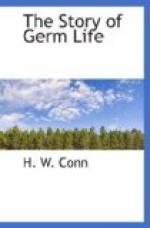These organisms are thus to be regarded as parasites of the red corpuscles. It is, of course, easy to believe that an extensive parasitism and destruction of the corpuscles would be disastrous to the health of the individual, and the severity of the disease will depend upon the extent of the parasitism. Corresponding to this life history of the organism, the disease malaria is commonly characterized by a decided intermittency, periods of chill and fever alternating with periods of intermission in which these symptoms are abated. The paroxysms of the disease, characterized by the chill, occur at the time that the spores are escaping from the blood-corpuscles and floating in the blood. After they have again found their way into a blood-corpuscle the fever diminishes, and during their growth in the corpuscle until the next sporulation the individual has a rest from the more severe symptoms.
There appears to be more than one variety of the malarial organism, the different types differing in the length of time it takes for their growth and sporulation. There is one variety, the most common one, which requires two days for its growth, thus giving rise to the paroxysm of the disease about once in forty-eight hours; another variety appears to require three days for its growth; while still another variety appears to be decidedly irregular in its period of growth and sporulation. These facts readily explain some of the variations in the disease. Certain other irregularities appear to be due to a different cause. More than one brood of parasites may be in the blood of the individual at the same time, one producing sporulation at one time and another at a different time. Such a simultaneous growth of two independent broods may plainly produce almost any kind of modification in the regularity of the disease.
The malarial organism appears to be very sensitive to quinine, a very small quantity being sufficient to kill it. Upon this point depends the value of quinine as a medicine. If the drug be present in the blood at the time when the spores are set free from the blood-corpuscle, they are rapidly killed by it before they have a chance to enter another corpuscle. During their growth in the corpuscle they are far less sensitive to quinine than when they exist in the free condition as spores, and at this time the drug has little effect.
The malarial organism is an animal, and can not be cultivated in the laboratory by any artificial method yet devised. Its whole history is therefore not known. It doubtless has some home outside the blood of animals, and very likely it may pass through other stages of a metamorphosis in the bodies of other animals. Most parasitic animals have two or more hosts upon which they live, alternating from one to the other, and that such is the case with the malarial parasite is at least probable. But as yet bacteriologists have been unable to discover anything very definite in regard to the matter. Until we can learn something in regard to its life outside the blood of man we can do little in the way of devising methods to avoid it.




